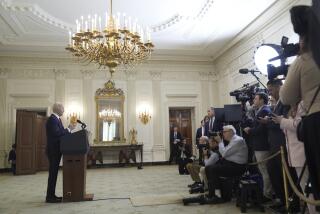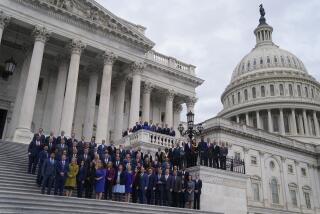Truth and spies
The National Mall and its monuments. The cherry blossoms. The National Archives. The Georgetown waterfront. The museums at Smithsonian Institution.
The monotony.
Washington, D.C., is a great town, but after a few visits, many of its traditional attractions ultimately fall under the heading of “been there, done that.” Fortunately, the city has a plethora of new attractions dedicated to such institutions as journalism, law enforcement and science.
That’s why as soon as the Washington weather turned warm, I opted for a weekend there with my 11-year-old daughter, Nyaniso, in tow, discovering the city’s new offerings while adhering to a $500 budget.
The latter directive is a challenge, but many of D.C.’s national monuments, memorials and museums are free of charge, which often offsets inflated hotel and restaurant prices.
We committed to four reasonably priced attractions -- the Newseum, the International Spy Museum, the Marian Koshland Science Museum and a ride in an open-top tourist bus. We found tasty eats well within our budget. We got a good rate on a hotel near upmarket Dupont Circle. To further economize, we took the Metro to Washington from our home in Alexandria, Va.
The attractions we visited, however, were across town, adjacent to the Verizon Center and its adjoining shops and theaters -- a once-blighted spot that has become a magnet for tourists and locals alike.
Yet, because D.C. is one of the world’s best walking cities, we traveled mainly on foot, engaging in colorful daddy-daughter chats that lasted from one neighborhood to the next.
We began our excursion at the Newseum, the spanking new, state-of-the-art facility devoted to the Fourth Estate featuring an outside exhibit of enlarged newspapers from around the world. As I stood staring at the exhibit, I wondered: How soon will these papers be replaced with computer screens that display their corresponding Web pages?
It’s a fair question. With the rising popularity of the Internet as a news source, you would think newspapers were on their way out quicker than schoolchildren when the final bell rings.
That’s why our visit began here: If the place that featured journalism history was to portray my line of work as a thing whose time had mostly past, I wanted to get it over with.
As it turns out, the Newseum is one of the best things that has happened to the profession in years. With seven stories that feature 14 major galleries and 15 theaters, it is an innovative way to foster fascination and respect for truth gathering and truth telling.
The first major artifact in the Newseum sets the mood for everything that follows: four slabs and a checkpoint from the Berlin Wall. The amazing display details coverage of the graffiti-filled wall’s dismantling in 1989.
Another popular stop inside the Newseum is the 4-D movie that chronicles the role of journalism in various events in American history. With seats that move, lifelike visual images and theatrical effects such as water sprays and puffs of air, the 4-D experience is undoubtedly the future of entertainment. It makes HD seem like UHF.
One of the most memorable moments of the short film features journalist Nellie Bly, who admitted herself to an asylum for women to investigate rumors of inhumane treatment there.
As the movie displayed up-close images of rats moving in her dark, dreary room, theatrical effects from the theater floor level -- perhaps puffs of air -- made it feel as if rodents were moving across our feet. After the screams subsided (including the ones from my daughter), some folks raised their feet off the floor and refused to put them down until it was time to leave.
Yet, everyone cheered with delight during the film and some bemoaned that it ended so soon. When the credits rolled, a preteen girl seated to my right exclaimed, “That was [expletive] awesome!”
From there, we took an afternoon ride on the top deck of the sightseeing bus, which was ideal on a sunny day with 80-degree temperatures. It offered picturesque views of the nation’s capital, without our having to worry about getting around in traffic.
The bus’s public address system warned repeatedly that we top-deck riders were 14 feet in the air, and that we had to watch out for low-hanging branches and power lines (often, we had to duck).
What the announcement failed to say was that the bus sometimes traveled at rapid speed. That coupled with an occasional stiff wind created a gust that could blow a baseball cap right off your head.
I know. I lost mine to a crowd near Georgetown as we sped along.
Later, we took in a bite at a Latin American restaurant on 14th Street called Ceiba, which is named for a large species of tree found in Central and South America as well as the Caribbean.
The decor was dark enough to develop film, but the food -- from Spanish Caesar salad with Serrano ham to Cuban black bean soup -- was fantastic.
Then it was on to the Courtyard Embassy Row, an elegantly designed hotel catering to business travelers that, at $132 a night, was one of the most reasonably priced hotels in the city that weekend. By day’s end -- which was topped off with ice cream -- we were more than ready to rest our tired feet. Still the walking was well worth it; parking at the hotel is $32 a day.
Our Sunday began at the International Spy Museum, reputed as the only museum in the nation devoted to intelligence gathering. It’s also one of few museums in D.C. that opens as early as 9 a.m. on Sunday.
The five-building collection of exhibitions and artifacts wows visitors with espionage themes from the moment they head to displays in an elevator with colorful fluorescent lights along its translucent floor.
Visitors who choose to be a pretend spy assume a fake ID and must memorize their age, city of origin, business and family information when asked by various computer programs. They can also learn how to catch a spy and how to elude capture.
The most popular attraction for kids is an overhead duct that they crawl through to advance to other rooms (most kids bang on the tin sides as they move along). Adults seem to enjoy the different types of James Bond-type guns that were once used by Soviet, British and U.S. intelligence operatives.
They include: a lipstick gun once used by the KGB; a glove pistol once used by the U.S. Navy; and a tobacco pipe pistol once used by British special forces.
Our final stop, the Marian Koshland Science Museum, was the most informative but least entertaining. It was just one floor and two rooms, and it mostly involved videos and presentations shown on flat-screen televisions.
The museum featured great displays that demonstrated where deadly diseases are ravaging the planet and how the universe is expanding, but it wasn’t as interactive as the previous two stops. It’s ideal for those who enjoy a Smithsonian-type of atmosphere.
Still, it helped make for a fun weekend in Washington, and we topped it off with a hearty meal at Ruby Tuesday near Verizon Center, just before a cold front settled in with a steady drizzle.
If we had timed our visit a few weeks later, we would have been able to see the new National Museum of Crime & Punishment. The museum will be the new home of the Fox TV series, “America’s Most Wanted,” hosted by John Walsh.
But we will be back. The Spy Museum and Newseum are so loaded with attractions that it’s hard to absorb all there is to see in one trip. And, because each of the venues is reasonably priced, it’s possible to enjoy them without losing your shirt.
Holding on to your hat is another story.
More to Read
Sign up for The Wild
We’ll help you find the best places to hike, bike and run, as well as the perfect silent spots for meditation and yoga.
You may occasionally receive promotional content from the Los Angeles Times.






